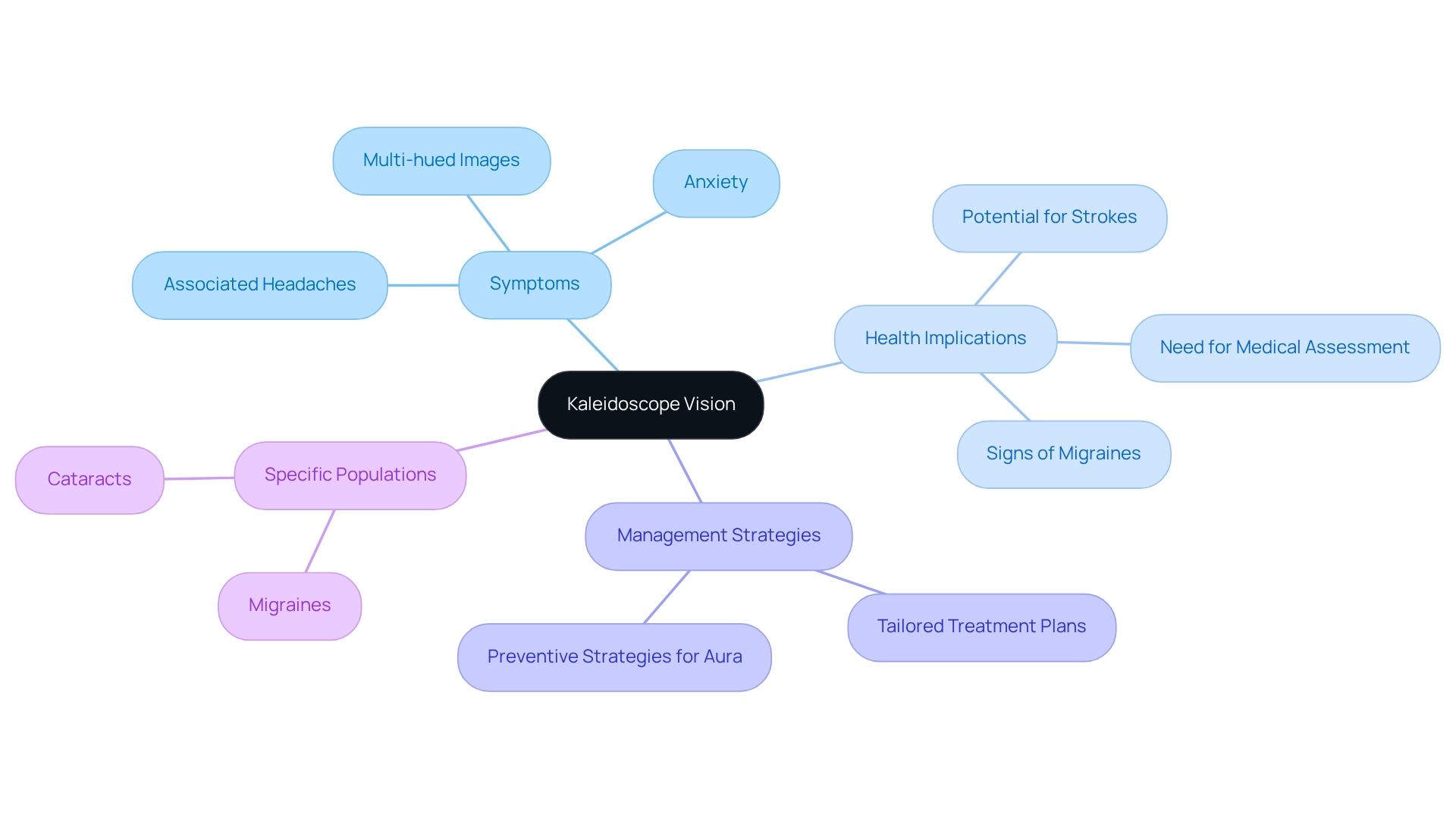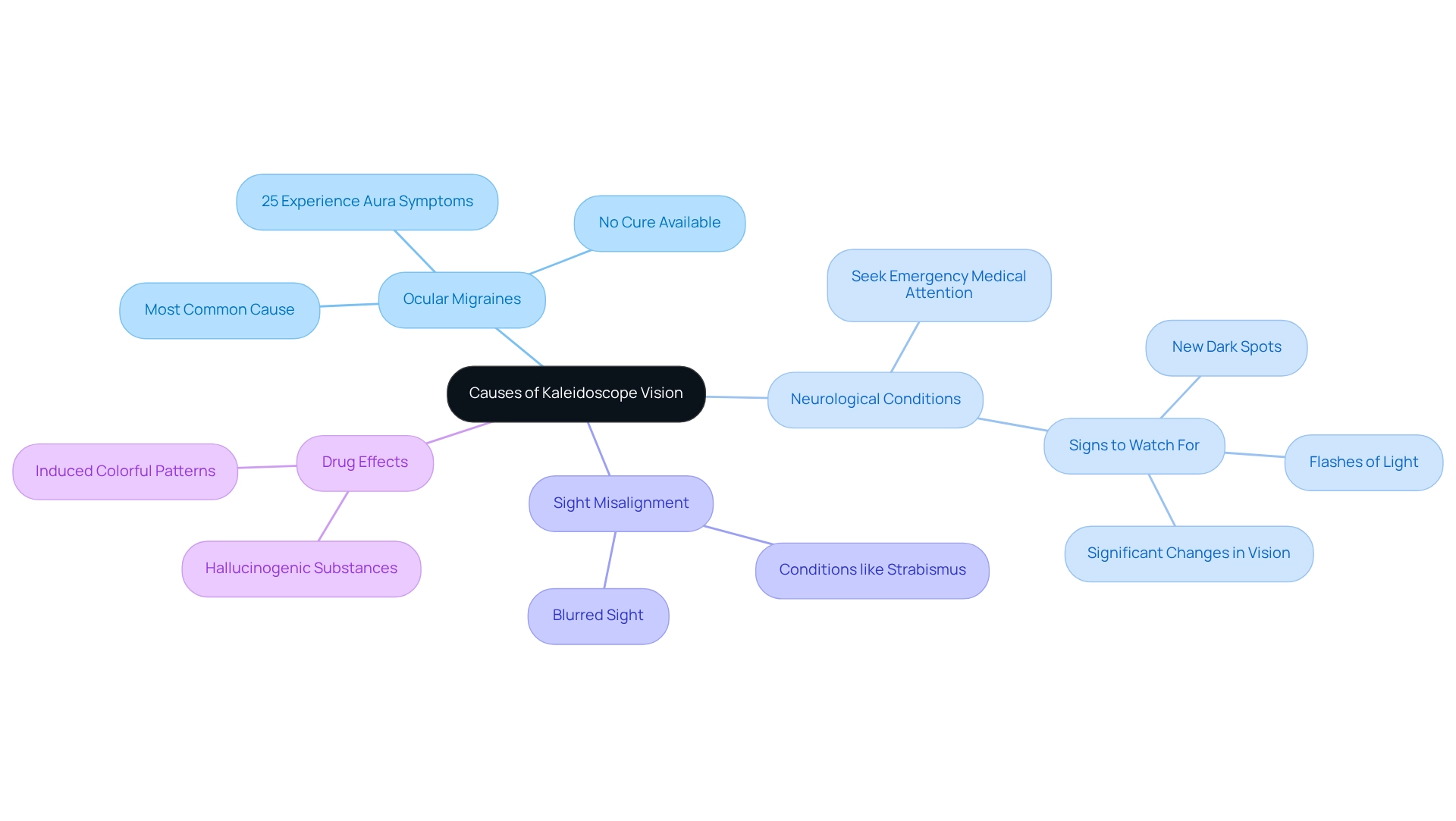Posted by: Northwest Eye in General on May 24, 2025
Overview
Kaleidoscope vision can be unsettling, characterized by distorted sight that often presents as multi-hued, fragmented images. We understand that experiencing this can raise concerns about underlying health issues, such as migraines or neurological conditions. It’s important to recognize these symptoms and seek timely medical intervention.
This article emphasizes the significance of addressing your feelings and concerns. By discussing various treatment options—including medication, lifestyle changes, and regular eye exams—we aim to provide reassurance and guidance. These steps can help manage and reduce the frequency of these episodes, allowing you to feel more in control of your health.
Remember, you are not alone in this journey. We are here to help you through this process, ensuring you have the support and information you need to navigate your experiences with kaleidoscope vision.
Introduction
In a world where visual clarity is often taken for granted, kaleidoscope vision emerges as a perplexing phenomenon that can disrupt everyday life. We understand that experiencing fragmented, multi-colored images can be unsettling. This temporary visual disturbance is frequently associated with migraines and other neurological conditions.
Understanding kaleidoscope vision is not just about recognizing its vivid symptoms; it also plays a crucial role in identifying potential underlying health issues that may require medical attention. As individuals navigate the complexities of this condition, awareness of its causes, symptoms, and treatment options becomes essential for effective management and improved quality of life.
We are here to help you through this process.
Define Kaleidoscope Vision and Its Significance
Kaleidoscopic sight can be a disconcerting experience, characterized by the observation of multi-hued, fragmented images, much like looking through a kaleidoscope. We understand that this phenomenon often occurs alongside headaches or other neurological conditions, which can be concerning. Identifying distorted sight is essential, as it may signify underlying health problems that require medical assessment. While it is not , it serves as a symptom that may signal more serious concerns, such as migraines or strokes.
It’s common to feel anxious during episodes of kaleidoscope vision, but it’s reassuring to know that they usually resolve within 60 minutes. However, if unexpected occurrences arise, seeking immediate medical attention is crucial due to their potential association with serious conditions. Recent studies emphasize the importance of understanding the features and duration of auras, which can help distinguish them from other serious health concerns. According to Susan McBratney, PhD, a staff writer and medical editor at Healthgrades, grasping these symptoms is vital for timely intervention.
Moreover, a case study titled “Preventive Strategies for Aura” outlines various management options. Implementing a tailored treatment plan can significantly help reduce the frequency and severity of aura episodes in patients with migraines. For those with cataracts, being aware of these symptoms is especially important, as they may encounter disturbances in sight linked to their condition. By recognizing these symptoms, individuals can take proactive steps toward seeking appropriate care, ensuring their health and well-being.

Identify Symptoms of Kaleidoscope Vision
Symptoms of kaleidoscope vision can present themselves in various ways, and we recognize how concerning this can be. These may include:
- Visual Distortions: You might experience bright, swirling colors or fragmented images that create .
- Duration: These episodes typically last from a few minutes to an hour. However, some individuals report variations in duration, which can be unsettling.
- Kaleidoscope Vision: For some individuals, experiencing kaleidoscope vision may serve as a precursor to a headache attack, acting as an important warning sign.
It’s common for kaleidoscope vision to be associated with headaches or severe headaches, indicating a potential link between visual disturbances and headache conditions.
Recognizing these symptoms is essential, especially for those who experience them frequently or alongside other concerning signs. We encourage you to seek timely medical advice. Research indicates that the occurrence of likely migraines impacts 5%–15% of the overall population each year. Additionally, individuals with cataracts may be more vulnerable to these disturbances due to . Neurologists emphasize that while there are no proven treatments for associated conditions like aura, management strategies focus on reassurance and monitoring for spontaneous remission.
For instance, a patient experiencing distorted sight may find daily activities, such as reading or driving, become challenging during episodes. This reinforces the need for awareness and proactive health measures. Furthermore, the case study titled “Treatment Approaches for Migraine With Aura” highlights the importance of ongoing research into effective management strategies for patients experiencing these symptoms. Monika Singla, a neurologist, observes that there is no consistent relationship between headache duration and the side of headache with aura, further illustrating the complexity of these sensory disturbances.
By understanding these symptoms and their implications, we hope you feel empowered to navigate your eye health and seek appropriate care. Remember, we are here to help you through this process.
Explore Causes of Kaleidoscope Vision
Kaleidoscope vision can arise from various underlying factors, each contributing to the unique disturbances individuals may experience. We understand that encountering these symptoms can be concerning, so let’s explore together:
- Ocular Migraines: This is the most common reason people report sight disturbances, often appearing before or during a headache episode. Approximately 25% of individuals with severe headaches experience aura symptoms, such as distorted sight. It’s important to recognize that there is currently no remedy for migraines or auras, which can pose ongoing challenges for those affected.
- Neurological Conditions: Severe conditions like strokes or transient ischemic attacks (mini-strokes) can lead to distorted sight. If you experience these symptoms, seeking emergency medical attention is crucial, as timely intervention can be life-saving. Signs that warrant a healthcare visit include new dark spots, flashes of light, and significant changes in your vision, particularly if you experience kaleidoscope vision due to retinal issues which can cause substantial distortions in sight. These conditions require immediate evaluation by an eye care professional. Additionally, unclear sight may signal retinal problems, which could also lead to colorful patterns.
- Sight Misalignment: Conditions such as strabismus can create misalignments in sight, resulting in colorful symptoms. Understanding the connection between eye alignment and perception is vital for effective treatment. Blurred sight may also accompany strabismus, further complicating your visual experience.
- Drug Effects: Certain hallucinogenic substances can induce visual experiences akin to colorful patterns, showcasing the influence of external factors on sight perception.
Recognizing these causes is essential for determining the appropriate course of action and treatment. For instance, effective headache management strategies—including medication, lifestyle adjustments, and relaxation techniques—can significantly reduce the frequency and severity of episodes, ultimately enhancing your quality of life. By understanding the link between ocular migraines and distorted sight, you can better manage your symptoms and seek prompt medical guidance.
If you are experiencing distorted sight or swirling patterns, please remember that it is crucial to consult a healthcare expert. These signs may indicate that require attention, and we are here to help you through this process.

Discuss Treatment Options for Kaleidoscope Vision
Treatment options for improving kaleidoscope vision are tailored to the underlying causes and can significantly enhance patient outcomes. We understand that dealing with visual disturbances can be unsettling, and we are here to help you through this process.
- Medication: For those experiencing eye-related headaches, triptans are often prescribed to alleviate symptoms effectively. These medications focus on the vascular alterations linked to headaches, offering relief from the visual disturbances. A review of subgroup analyses in migraine trials suggests that the efficacy of migraine prophylactic drugs may be consistent across different patient subgroups, reinforcing the reliability of triptans as a treatment option.
- Lifestyle Changes: Identifying and managing triggers is crucial. It’s common to feel overwhelmed by factors such as stress, dehydration, and irregular sleep patterns that can exacerbate episodes. By applying methods to sustain a balanced lifestyle, you can experience a significant decrease in the frequency of visual disturbances. Studies indicate that lifestyle modifications can reduce episodes by up to 30%, highlighting the importance of proactive management.
- Sight Therapy: Individuals experiencing visual misalignment may benefit from . This method emphasizes enhancing eye coordination and may assist in reducing symptoms related to distorted sight.
- Regular Eye Exams: Routine check-ups with an ophthalmologist are essential for monitoring eye health. We understand that regular assessments can feel like a chore, but these examinations can help detect underlying issues early, allowing for timely intervention and management. As emphasized by Simona Sacco, regular assessments are vital for maintaining optimal eye health and addressing potential complications.
- Emergency Care: It is crucial to seek prompt medical assistance if distorted sight is accompanied by severe headaches, loss of sight, or other neurological symptoms. These could indicate more serious conditions that require urgent care, and by understanding and utilizing these treatment options, you can take proactive steps toward effectively managing your kaleidoscope vision. Remember, you are not alone in this journey, and support is available to help you through it.
Conclusion
Kaleidoscope vision can be a startling experience, often temporary and linked with migraines, yet it is a significant symptom that deserves our attention due to its potential connections to serious health issues. We understand that recognizing the characteristics, causes, and treatment options related to this visual disturbance is essential for those who experience it. By identifying symptoms such as visual distortions and their duration, you can navigate your health more effectively and seek timely medical advice, especially if these episodes occur frequently or are accompanied by other concerning signs.
The causes of kaleidoscope vision are diverse, ranging from ocular migraines to more serious neurological conditions, retinal issues, and even visual misalignment. Each cause presents unique challenges and treatment considerations. Therefore, being aware of these underlying factors is vital in determining the best course of action for your health. Effective management strategies, including medication, lifestyle changes, and regular eye exams, can significantly enhance your quality of life if you are affected by kaleidoscope vision.
Ultimately, awareness and proactive management are key. By staying informed about the symptoms and potential causes of kaleidoscope vision, you can take charge of your health and ensure you receive the necessary care. This approach not only helps alleviate the immediate discomfort associated with visual disturbances but also addresses any serious underlying conditions that may be present. Recognizing the importance of timely intervention can make a meaningful difference in your health outcomes and overall well-being.
Frequently Asked Questions
What is kaleidoscopic sight?
Kaleidoscopic sight is a disconcerting experience characterized by the observation of multi-hued, fragmented images, similar to looking through a kaleidoscope.
What conditions are often associated with kaleidoscopic sight?
Kaleidoscopic sight often occurs alongside headaches or other neurological conditions, potentially indicating underlying health problems.
Is kaleidoscopic sight a standalone condition?
No, kaleidoscopic sight is not a standalone condition; it serves as a symptom that may signal more serious concerns, such as migraines or strokes.
How long do episodes of kaleidoscopic vision typically last?
Episodes of kaleidoscopic vision usually resolve within 60 minutes.
When should someone seek medical attention for kaleidoscopic sight?
Immediate medical attention should be sought if unexpected occurrences arise, as they may be associated with serious conditions.
Why is it important to understand the features and duration of auras?
Understanding the features and duration of auras can help distinguish them from other serious health concerns, allowing for timely intervention.
What management options are available for those experiencing aura episodes?
A case study titled “Preventive Strategies for Aura” outlines various management options, including tailored treatment plans to reduce the frequency and severity of aura episodes in patients with migraines.
How can individuals with cataracts relate to kaleidoscopic sight?
Individuals with cataracts should be aware of symptoms like kaleidoscopic sight, as they may encounter disturbances in sight linked to their condition, prompting them to seek appropriate care.






